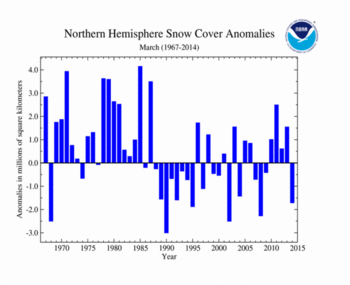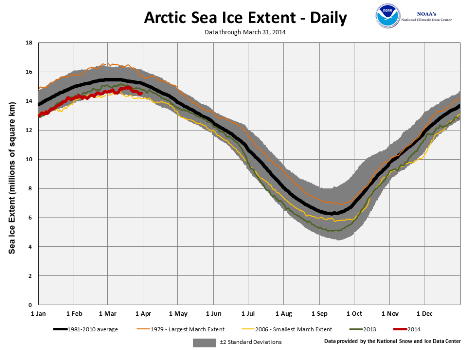NH Snow Cover Extent
| March 2014 | Snow Cover Extent | Anomaly 1991-2020 | Trend per decade | Rank (48 years) | Record | ||||||
|---|---|---|---|---|---|---|---|---|---|---|---|
| million km² | million mi² | million km² | million mi² | million km² | million mi² | Year(s) | million km² | million mi² | |||
| Northern Hemisphere | 38.41 | 14.83 | -1.38 | -0.53 | -0.40 | -0.15 | Largest | 43rd | 1985 | 44.28 | 17.10 |
| Smallest | 6th | 1990 | 37.12 | 14.33 | |||||||
| North America | 16.20 | 6.25 | +0.50 | +0.19 | -0.04 | -0.02 | Largest | 16th | 1969 | 17.29 | 6.68 |
| Smallest | 33rd | 1968 | 14.04 | 5.42 | |||||||
| Eurasia | 22.21 | 8.58 | -1.88 | -0.73 | -0.36 | -0.14 | Largest | 45th | 1981 | 27.95 | 10.79 |
| Smallest | 4th | 2002 | 21.18 | 8.18 | |||||||
Data Source: Global Snow Laboratory, Rutgers University. Period of record: 1967–2014 (48 years)
The Northern Hemisphere snow cover extent (SCE) during March 2014 was 38.41 million square km (14.83 million square miles), which was 1.72 million square km (660,000 square miles) below the 1981-2010 average. This was the sixth smallest March SCE for the Northern Hemisphere in the 48-year period of record, and the smallest since 2008. The Eurasian SCE was much below average, while the North American SCE was above average. The Northern Hemisphere SCE during March is decreasing at an average rate of 400,000 square km (150,000 square miles), or one percent, per decade.
The March North American SCE was 16.20 million square km (6.25 million square miles), which was 560,000 square km (220,000 square miles) above the 1981-2010 average. This was the 16th largest March SCE on record for North America. In Canada, above-average snow cover was observed across the Rockies, the southern Prairies, and the Great Lakes region. In the U.S., above-average snow cover was observed across the Northern Rockies and Plains, the Midwest, the Mid-Atlantic, and the Northeast. Below-average snow cover was observed in the U.S. from the Southern Rockies to California, and northward into the Pacific Northwest. Although March SCE was above average this year, North American SCE during March is decreasing at an average rate of 40,000 square km (15,000 square km), or 0.3 percent per decade.
The Eurasian SCE during March was 22.21 million square km (8.58 million square miles), 2.28 million square km (880,000 square miles) below the 1981-2010 average, and the fourth smallest March SCE on record. This was the smallest March SCE since 2008. Below-average snow cover was observed across much of Europe, Turkey, western Iran, Mongolia, western China, and southern Russia. Above-average snow cover was observed across parts of the Tibetan Plateau and the Himalayas. March SCE across Eurasia is decreasing at an average rate of 360,000 square km (140,000 square miles), or 1.5 percent per decade.
Sea Ice Extent
| March 2014 | Sea Ice Extent | Anomaly 1991-2020 | Trend per decade | Rank (36 years) | Record | ||||
|---|---|---|---|---|---|---|---|---|---|
| million km² | million mi² | Year(s) | million km² | million mi² | |||||
| Northern Hemisphere | 14.76 | 5.70 | -1.80% | -2.46% | Largest | 32nd | 1979 | 16.34 | 6.31 |
| Smallest | 5th | 2006 | 14.42 | 5.57 | |||||
| Southern Hemisphere | 4.90 | 1.89 | +20.10% | +4.90% | Largest | 3rd | 2008 | 5.28 | 2.04 |
| Smallest | 34th | 2006 | 3.21 | 1.24 | |||||
| Globe | 19.66 | 7.59 | +2.88% | -0.89% | Largest | 15th | 2008 | 20.46 | 7.90 |
| Smallest | 22nd | 2006 | 17.63 | 6.81 | |||||
Data Source: National Snow and Ice Data Center (NSIDC). Period of record: 1979–2014 (36 years)
According to the National Snow and Ice Data Center (NSIDC), the Northern Hemisphere sea ice extent — which is measured from passive microwave instruments onboard NOAA satellites — averaged for March 2014 was 14.76 million square km (5.70 million square miles), which was 730,000 square km (280,000 square miles), or 4.7 percent, below the 1981-2010 average. The March 2014 Arctic sea ice extent was 330,000 square kilometers (127,000 square miles) larger than the record smallest March sea ice extent that occurred in 2006, and ranked as the fifth smallest March Arctic sea ice extent on record. Below-average sea ice was observed in the Barents Sea and the Sea of Okhotsk, with the rest of the Arctic experiencing near-average sea ice. March Arctic sea ice extent is decreasing at an average rate of 2.5 percent per decade.
The annual maximum sea ice extent for the Arctic occurred on March 21st at 14.91 million square kilometers (5.76 million square miles), also ranking as the fifth smallest on record. The maximum extent occurred during a late-month surge in ice expansion when wind patterns pushed ice into the Barents and Bering Seas, where below-average ice cover was observed during most of the ice growth season. The sea ice maximum was 12 days later than average and the fifth latest sea ice maximum occurrence on record. The latest annual maximum occurred on March 31st in 2010, while the smallest annual maximum occurred in 2011 at 15.63 million square km (5.65 million square miles).
The March 2014 Southern Hemisphere sea ice extent was 5.30 million square km (2.05 million square miles), 890,000 square km (350,000 square miles), or 20.2 percent, above the 1981-2010 average. This was the third largest March Antarctic sea ice extent on record, smaller only than the March Antarctic sea ice extents of 2008 and 2013.
When combining the Northern and Southern Hemisphere sea ice extents, the globally-averaged sea ice extent during March was 20.06 million square km (7.75 million square miles), 0.8 percent above the 1981-2010 average and the 18th largest (20th smallest) March global sea ice extent on record. Global sea ice extent during March is decreasing at an average rate of 1.0 percent per decade.
For further information on the Northern and Southern Hemisphere snow and ice conditions, please visit the NSIDC News page.
 NOAA's National Centers for Environmental Information
NOAA's National Centers for Environmental Information





